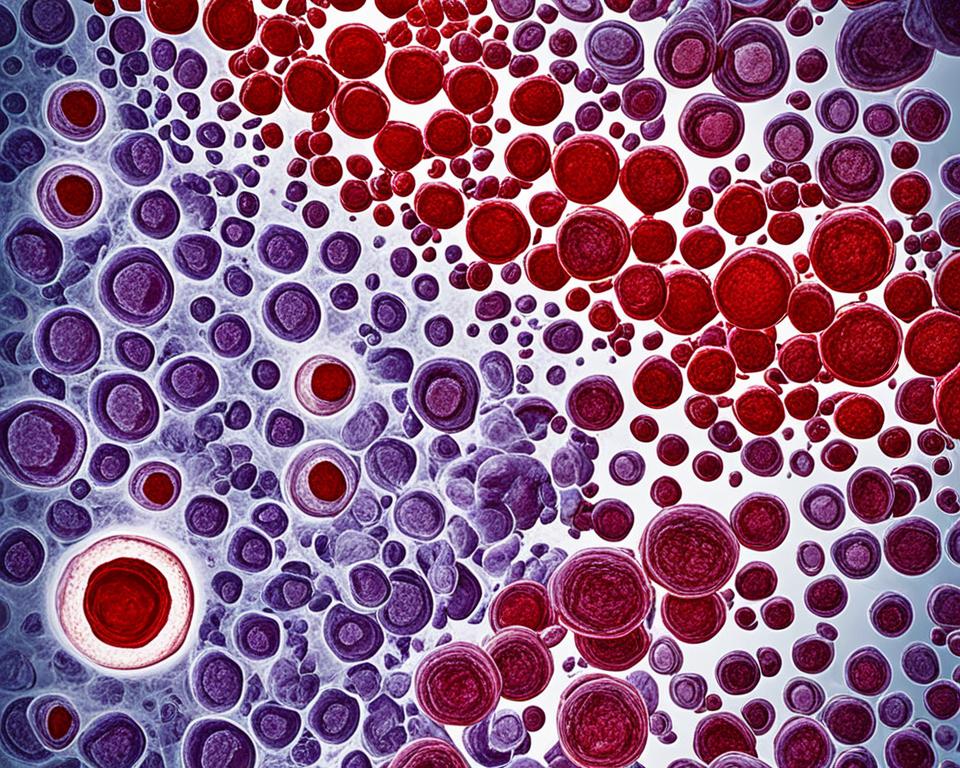Multiple myeloma is a bone marrow cancer that affects blood health, causing anemia. This article will cover symptoms and treatment options for this blood disorder. It aims to give readers a clear understanding of its causes, effects, and new management strategies.
Multiple myeloma starts in the bone marrow as a plasma cell neoplasm. These abnormal cells can stop the normal production of red blood cells. This leads to a lack of oxygen in the body, causing anemia. This condition greatly affects patients, impacting their life quality and well-being.
Read interesting things at : apportfolioasia
Key Takeaways
- Multiple myeloma anemia is a common complication of bone marrow cancer, resulting in a deficiency of red blood cells.
- Symptoms of multiple myeloma anemia can include fatigue, weakness, shortness of breath, and cognitive impairment.
- Diagnostic tests, such as blood tests and bone marrow biopsies, are crucial for identifying the type and severity of the anemia.
- Treatment options for multiple myeloma anemia include iron supplements, erythropoiesis-stimulating agents, and blood transfusions, depending on the underlying cause.
- Ongoing research and clinical trials are exploring new therapies to manage multiple myeloma anemia and improve patient outcomes.
Understanding Multiple Myeloma Anemia
Multiple myeloma is a type of plasma cell neoplasms, affecting the bone marrow. It often leads to anemia, a condition where the body doesn’t make enough red blood cells. This happens because the cancerous cells take over the bone marrow, reducing red blood cell production.
What Is Multiple Myeloma Anemia?
Anemia is a blood disorder that often comes with multiple myeloma. The cancerous cells in the bone marrow take up space, making fewer red blood cells. This leads to a lack of oxygen in the body, causing anemia symptoms.
Causes and Risk Factors
The main cause of anemia in multiple myeloma is the cancerous plasma cells in the bone marrow. These cells grow too much and stop normal blood cells from being made. Chemotherapy or radiation for the cancer can also make anemia worse by harming the bone marrow.
Older people, those with a weak immune system, and those with a family history of blood cancers are more likely to get anemia from multiple myeloma. Having a family history of these cancers can also increase the risk.
“Understanding the complex relationship between multiple myeloma and anemia is crucial for effective disease management and improving patient outcomes.”
Symptoms of Multiple Myeloma Anemia
People with multiple myeloma anemia face many physical and mental symptoms. These symptoms greatly affect their daily life. It’s important to know and manage them well.
Physical Symptoms
One key symptom is feeling very tired, even after resting. This is because of the lack of red blood cells and low hemoglobin levels. Weakness and trouble breathing are also common, as the body can’t carry oxygen well to tissues.
Plus, the skin looks pale and there’s more bruising because of fewer red blood cells.
Psychological and Cognitive Impacts
The mental and thinking problems from multiple myeloma anemia can be tough. It’s hard to focus, remember things, and mood swings like feeling sad or anxious happen often. These issues make it hard to keep up with usual activities.
| Physical Symptoms | Psychological and Cognitive Impacts |
|---|---|
|
|
It’s key to understand how multiple myeloma anemia affects both body and mind. This helps doctors, patients, and caregivers work together to manage the condition and support each other.
“Anemia can have a profound impact on an individual’s physical and mental well-being, making it essential to address both the red blood cell deficiency and the associated psychological effects.”
Diagnosing Multiple Myeloma Anemia
Diagnosing multiple myeloma anemia involves blood tests and a bone marrow biopsy. These tests help doctors understand how severe the anemia is and what’s causing it.
Blood tests are key in the early stages of diagnosis. Doctors check the patient’s hemoglobin levels to see how bad the anemia is. They also look for other signs like red blood cell count, hematocrit, and mean corpuscular volume. These tests give clues about the type and cause of the anemia.
If blood tests suggest multiple myeloma, doctors might suggest a bone marrow biopsy. This test takes a small sample of bone marrow from the hip or breastbone. It helps find malignant plasma cells, which are signs of multiple myeloma, and checks the bone marrow’s health.
“Diagnosing multiple myeloma anemia requires a comprehensive approach, combining various diagnostic methods to ensure accurate identification of the underlying condition and guide appropriate treatment.”
Using blood tests and bone marrow biopsy together, doctors can accurately diagnose multiple myeloma anemia. This helps them create a treatment plan that meets the patient’s needs.
Types of Multiple Myeloma Anemia
Multiple myeloma is a type of cancer that affects plasma cells. It can cause different kinds of anemia. The main types are iron deficiency anemia and anemia of chronic disease.
Iron Deficiency Anemia
Iron deficiency anemia is common in people with multiple myeloma. It happens when the body doesn’t have enough iron. Iron is key for making red blood cells. In multiple myeloma, it can be hard to get enough iron because of the disease.
Anemia of Chronic Disease
Anemia of chronic disease is another type seen in those with multiple myeloma. It’s caused by the body’s ongoing fight against the disease. This fight can make it hard for the body to use and move iron around, leading to anemia.
| Type of Anemia | Characteristics | Underlying Cause |
|---|---|---|
| Iron Deficiency Anemia | Low hemoglobin, small red blood cells, low iron stores | Decreased intake or absorption of iron, increased iron demands due to rapid plasma cell proliferation |
| Anemia of Chronic Disease | Mild to moderate anemia, normal or high iron stores, low iron availability | Chronic inflammatory response to underlying multiple myeloma, which interferes with iron utilization and transport |
Knowing about the anemias linked to multiple myeloma helps in making a good treatment plan. Diagnosing and treating these anemias can greatly improve life quality for those with this serious disease.
Treatment Options for Multiple Myeloma Anemia
Patients with multiple myeloma anemia have several treatment options. These include iron supplements, dietary changes, erythropoiesis-stimulating agents, and blood transfusions.
Iron Supplements and Dietary Changes
Addressing iron deficiency is key in fighting multiple myeloma anemia. Iron supplements can help increase iron levels and boost red blood cell production. Eating more iron-rich foods like red meat, leafy greens, and fortified cereals is also helpful.
Erythropoiesis-Stimulating Agents
When the body can’t make enough red blood cells, erythropoiesis-stimulating agents (ESAs) might be given. These drugs make the bone marrow produce more red blood cells. This helps fight anemia and improve oxygen delivery in the body.
Blood Transfusions
For severe or life-threatening anemia, blood transfusions may be needed. They quickly increase hemoglobin levels and help with oxygen supply. But, they don’t fix the underlying cause of anemia.
Patients with multiple myeloma anemia should work closely with their healthcare team. Together, they can find the best treatment plan for their condition and needs.
Multiple Myeloma Anemia and Bone Marrow Health
Multiple myeloma is a type of cancer that affects the bone marrow. This organ makes red blood cells. The disease can harm the bone marrow, leading to fewer healthy red blood cells. This is called multiple myeloma anemia.
When cancerous plasma cells grow in the bone marrow, they take up space. This stops normal blood cells from growing. So, there are fewer red blood cells, making it hard for the body to carry oxygen. This red blood cell deficiency is a key sign of multiple myeloma anemia.

Multiple myeloma also affects the production of platelets and white blood cells. This can lead to more infections, bleeding, and more anemia. It’s a big problem for patients.
It’s important to understand how multiple myeloma affects the bone marrow. This helps doctors find the right treatments. By fixing the bone marrow issues, doctors can help manage the anemia and improve patients’ health.
Managing Side Effects of Anemia Treatment
When dealing with multiple myeloma anemia, knowing about side effects is key. These can include stomach issues and reactions to blood disorders transfusions. Understanding and tackling these effects helps patients stay comfortable during treatment.
One common issue is stomach discomfort like nausea, vomiting, or constipation. Doctors might change the dose of medication, suggest diet changes, or give anti-nausea drugs as needed.
Getting blood transfusions can also cause reactions, from mild fever to serious allergic reactions. Keeping a close eye on patients and using medicines to prevent reactions can help manage these issues.
- Proactively address stomach side effects by adjusting meds and changing diets
- Watch for blood transfusion reactions and take steps to prevent them
- Keep in touch with doctors to quickly spot and handle any side effects
By being alert and working with their healthcare team, patients with multiple myeloma anemia can handle side effects of their treatment management. This helps them keep their blood disorders under control and feel better overall.
“Effective management of anemia treatment side effects is crucial for ensuring patient comfort and adherence to the prescribed therapies.”
The Role of Supportive Care
In managing multiple myeloma anemia, supportive care is key. It helps keep a patient’s quality of life high. This approach covers physical, emotional, and practical needs of those with this blood disorder.
Supportive care aims to ease symptoms of multiple myeloma anemia and manage treatment side effects. It uses medicines for fatigue, pain, and other symptoms. It also offers daily activity help through assisted living services.
It also focuses on emotional and psychological support. Patients get counseling, support groups, and resources to deal with the condition’s challenges.
Supportive care’s main goal is to help patients keep a good quality of life during treatment and recovery. It meets physical, emotional, and practical needs. This makes a big difference in outcomes and well-being for those with this blood disorder.
| Supportive Care Strategies | Benefits |
|---|---|
| Medication management | Alleviates symptoms and side effects |
| Assisted living services | Helps with daily tasks and activities |
| Counseling and support groups | Provides emotional and psychological support |
| Nutritional counseling | Improves dietary intake and overall health |
“Supportive care is essential in helping patients with multiple myeloma anemia maintain their quality of life and cope with the challenges of their condition.”
Healthcare providers use various supportive care strategies to help patients and their families. This ensures multiple myeloma anemia is well-managed. It helps patients keep a high quality of life.
Coping Strategies for Patients and Caregivers
Living with multiple myeloma anemia is tough for both patients and caregivers. But, there are ways to make it easier and improve life quality.
Stress management is key for everyone. Techniques like meditation, deep breathing, and yoga can cut stress and help you relax. Doing some light exercises can also lift your mood and energy.
Being part of a support group, online or in-person, is great. It lets patients and caregivers share stories, learn, and get emotional support. Talking openly with doctors is also important. They can offer advice and resources to tackle the challenges of living with this condition.
| Coping Strategies for Patients | Coping Strategies for Caregivers |
|---|---|
|
|
Using these strategies, patients and caregivers can better handle the challenges of multiple myeloma anemia. They can find more strength and hope.

“Taking care of yourself is just as important as caring for your loved one. Remember to ask for help when you need it.”
Multiple Myeloma Anemia in Children
Pediatric anemia is a big challenge, especially in kids with cancer and blood cancers. Multiple myeloma, a blood cancer, causes a special kind of anemia in young people. It’s important to understand how to treat this anemia in kids.
Kids with this anemia may have trouble growing and developing. They also face physical and emotional symptoms. It’s key to watch them closely and give them the right care.
Specialized Treatment Approaches
Treating anemia in kids with multiple myeloma means working together with many doctors. Pediatric hematologists and oncologists use special treatments. This includes pediatric-specific doses of medicines and careful blood transfusions.
Supportive Care and Coping Strategies
Kids with anemia and their families need a lot of support. This includes learning resources, counseling, and a strong support network. Helping them cope and build a support circle can make a big difference.
Research and clinical trials are vital for improving treatments for kids with anemia and cancer. By focusing on their needs, doctors can give these kids the best care possible.
Preventing and Reducing the Risk of Anemia
Keeping a healthy lifestyle is key to avoiding and lowering the risk of anemia from multiple myeloma. By making some easy changes in your diet and handling health issues, you can act early to lower your anemia risk.
Dietary Strategies for Anemia Prevention
Eating foods high in iron is a top way to stop anemia. Good sources include red meat, poultry, seafood, beans, lentils, and leafy greens. Also, eating foods rich in vitamin C, like citrus fruits, helps your body absorb iron better.
| Iron-Rich Foods | Vitamin C-Rich Foods |
|---|---|
|
|
Adding these foods to your meals can help prevent and lower anemia risk.
Managing Underlying Conditions
It’s important to handle any health issues that might cause anemia. Conditions like chronic kidney disease, autoimmune disorders, and bleeding in the gut can lead to anemia. Working with your doctor to manage these can lower your risk of getting multiple myeloma anemia.
Regular check-ups and tests are key for catching anemia early. Your doctor might suggest blood tests to check your iron levels and overall blood health. This way, you can get help right away if there are any problems.
“Taking steps early to manage anemia risk can greatly improve your health and well-being.”
Ongoing Research and Clinical Trials
The medical community is working hard to improve our understanding and treatment of multiple myeloma anemia. Researchers are looking into new therapies and ways to manage this blood disorder. Through clinical trials, they are testing treatments that could make a big difference for patients.
They are focusing on targeted therapies that target the specific causes of multiple myeloma anemia. Scientists are checking out new drugs and treatment combinations. These could lead to better and longer-lasting ways to manage the condition.
Studies are also looking into personalized medicine. This means treatments that are made just for each patient. By using new technologies in genomics and molecular diagnostics, doctors hope to give patients more tailored care. This could lead to better results for those with multiple myeloma anemia.



